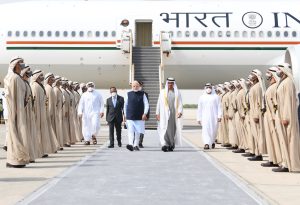Indian Prime Minister Narendra Modi was on a two-nation visit last week. He travelled to Germany first for the G-7 meeting and, on his way back, he stopped in the United Arab Emirates. It was Modi’s fourth visit to the country after visits in August 2015, February 2018, and August 2019. According to the Ministry of External Affairs (MEA), Modi was in the UAE to offer his personal condolences on the passing of Sheikh Khalifa bin Zayed Al Nahyan, the former UAE president and Abu Dhabi ruler. The visit also offered an opportunity for Modi to congratulate the new president of the UAE and the ruler of Abu Dhabi. Modi was accompanied by National Security Advisor Ajit Doval and Foreign Secretary Vinay Kwatra, among other officials.
But as Ambassador Navdeep Suri opined in a column recently, seen from a purely diplomatic protocol angle, “the visit was not necessary. Vice President Shri Venkaiah Naidu had gone to Abu Dhabi on 15 May to offer the Indian government’s condolences to the leadership of the UAE and in an unusual gesture, the External Affairs Minister, Dr S. Jaishankar, had personally visited the UAE embassy in New Delhi to sign the condolence book.” So, the visit was clearly meant for something beyond what was stated by the MEA.
The visit comes weeks after the controversial remarks by two BJP officials about Prophet Muhammad that created much anger and protests all across the Middle East including in the UAE. Like many other Muslim-majority countries, the UAE’s Ministry of Foreign Affairs and International Cooperation issued a statement condemning the controversial statements. The ministry also underscored “the importance of strengthening the shared international responsibility to spread the values of tolerance and human coexistence while preventing any practices that would inflame the sentiment of followers of different religions.”
Modi’s visit, therefore, offered an opportunity to soften the anger expressed against India. Even though it was a one-day visit, it appeared to have been an important one in cementing ties that may been adversely impacted by the recent developments, and an opportunity for a face-to-face interaction with the new leadership. Suri suggests that the brief visit was meant to renew the relationship with the leadership, as well as for “an engagement with key members of the royal family that include the national security adviser and the foreign minister.”
Clearly, it was an important gesture that could not be missed when Mohamed bin Zayed Al Nahyan received Modi at the airport, reflecting the personal ties between the two leaders. Modi tweeted that he was “touched by the special gesture of my brother, His Highness Sheikh Mohamed bin Zayed Al Nahyan, of coming to welcome me at Abu Dhabi airport. My gratitude to him.”
The UAE relationship is one India did not want to leave to chance. During a special briefing on Modi’s trip, Kwatra said that “the strategic partnership of India-UAE is a multidimensional strategic partnership, it is not just a strategic partnership” and includes different areas such as “defense, security, environment, education, health, commerce, [and] investment.” Commenting on the bilateral relationship, Dr. Aman Puri, the Consul General of India in Dubai said that “the relationship has been on swing for a few years and 2022 will be the inflection point.”
Patching up ties with the UAE assumes importance for a number of reasons. India and the UAE enjoy strong cultural and trade relations. The Indian community in the UAE is 35 percent of the UAE’s 10 million population, making it the largest expatriate community in the country. The two also have a strong trade and investment relations valued at $72 billion in 2021-22, making the UAE India’s third largest trade partner, after China and the United States. The UAE is also India’s second largest export destination. UAE’s FDI into India stands at more than US $12 billion.
During their meeting, the two leaders took stock of various aspects of the India-UAE Comprehensive Strategic Partnership including the Comprehensive Economic Partnership Agreement (CEPA) that was signed during their virtual summit in February this year. CEPA came into force on May 1. During their meeting in February, they also issued a fairly bold joint vision statement, “Advancing India and UAE Comprehensive Strategic Partnership: New Frontiers, New Milestones,” which has the potential to expand as well as widen the scope of the bilateral relations.
Given that the UAE is keen on transforming itself from an oil-dependent economy to a knowledge-based economy, the India-UAE relationship has the potential to expand to critical areas in the science, technology, innovation (STI) domain. With India’s strong science and technology base including in STEM education, space and nuclear fields, the two countries have the potential to transform the nature and scale of their engagement. The Indian decision to establish the first foreign branch of the Indian Institute of Technology (IIT) in the UAE fits well with this goal. The decision on the IIT’s UAE branch in Dubai is part of the CEPA agreement.
Apart from the bilateral economic and people-to-people ties, India and the UAE are also becoming more comfortable with the changing geopolitics of the region. The signing of the Abraham Accords in August 2020 opened new possibilities in relations between Israel and the UAE. The Middle East Quad involving India, Israel, the UAE and the United States is a case in point. The cooperation need not be on security and defense issues but the fact that the four with their own individual strengths can come together demonstrates the willingness to get out of their own comfort zones to explore new avenues of cooperation in various areas such as, for instance, critical and emerging technologies. This was all the more reason why India wanted to stabilize the relationship.

































